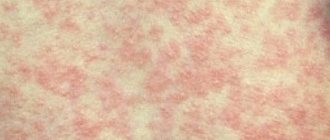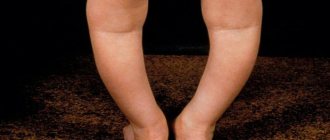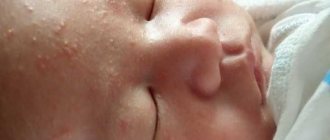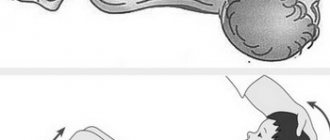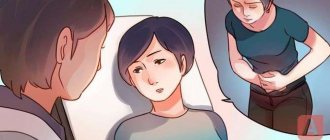Roseola in children (pseudo-rubella, three-day fever or sudden exanthema) is an infectious disease that mainly affects preschool children. The causative agent of the disease is herpes virus types 6 and 7.
Since almost every person on earth is a carrier of this type of infection, usually in adults the disease passes easily and unnoticed, since antibodies to the virus already exist in the blood. If there is a suspicion of the disease in adults, photos with explanations will help to understand the cause of the rash, but it is better to seek specialized help.
Symptoms of roseola in children are more pronounced; a rash almost always occurs.
The advantage of suffering from an illness is that antibodies remain in the blood, protecting the body throughout life.
If skin reactions occur in a child, parents should know what roseola and other diseases look like in order to be able to distinguish them and properly help the child. Many diseases have similar symptoms, but the treatment is completely different. Of course, parents immediately have many questions: how to treat it, is it possible to walk with roseola and wash the child?
Rash differentiation
There are many diseases of various origins, skin reactions in which manifest themselves on the baby’s body in a similar way.
With so many of them, the mother herself cannot distinguish a rash with roseola from rashes of a different nature.
You need to know the following about roseola rashes:
- The body temperature level is elevated for 2-4 days, after which skin reactions appear;
- First of all, small papules appear on the torso, quickly spreading to other parts of the body: face, arms and legs;
- Roseolas are characterized by a diameter of 1-6 mm, red color, due to the expansion of capillaries, around which there may be a pale corolla. They protrude slightly above the skin level;
- The elements of the rash do not merge with each other, have an irregular shape and an uneven contour;
- The rash does not cause itching or peeling of the skin;
- It does not leave complications in the form of pigmentation or scars;
- When you press on the spot, it turns pale, which is not typical for other skin infections;
- the disease is not characterized by other skin changes;
- The rash does not need to be lubricated with anything, as it does not cause discomfort.
The infectious disease roseola needs to be differentiated from others, so you need to know these features. This photo shows typical rashes on a baby's skin with pseudorubella.
Herpes virus and sudden exanthema in children
Herpes virus type six is the cause of the “sixth disease”. However, it is “sixth” not only because of the type of virus, but also because on average roseola lasts about six days. This disease is called “three-day fever” for the period of hyperthermia, usually expressed for no more than three days in the primary period. By the names “roseola” and “pseudo-rubella” one can draw conclusions about the main symptom of the disease - a pink-red rash on the child’s body. The modern name “sudden exanthema” is based on the truly sudden appearance of rashes without previous changes in the skin.
An early age of infection with this virus provokes the development of sudden exanthema, but in an adult body, according to research, the same virus may be responsible for human chronic fatigue syndrome.
What does it look like
Most of the symptoms of infantile roseola are general, that is, they are characteristic of almost any infection. These are nausea, loss of appetite and weakness.
Rash with roseola is a more typical symptom, but it can also cause difficulties even for an inexperienced doctor; parents themselves are unlikely to be able to make a diagnosis.
Changes in skin pattern, papular elements: rashes, spots, papules have the features described above. If they appear, you need to contact a pediatrician, infectious disease specialist or dermatologist. These doctors will be able to conduct additional studies and tests to accurately diagnose and prescribe the correct treatment.
Diseases with which the disease must first be differentiated, since their main symptom is also a rash:
- measles;
- rubella;
- allergic reaction;
- secondary syphilis;
- scarlet fever;
- medicinal toxicodermy.
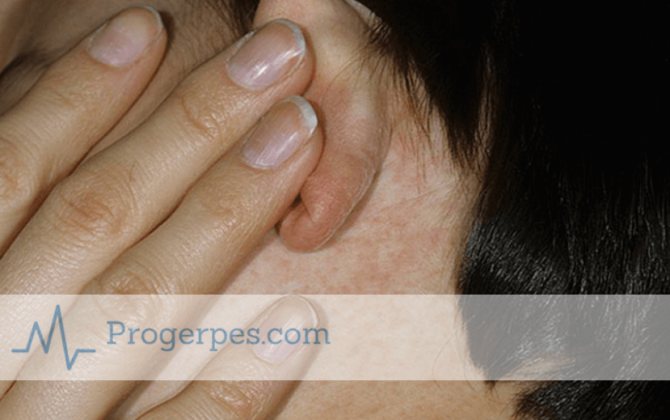
Parents should be alarmed if there is a sharp increase in temperature, since during this period, if the diagnosis is confirmed, febrile convulsions may occur; it is necessary to be able to prevent them. If the child is not sick with pseudorubella, he may require specific treatment. Serious complications are possible if some diseases are missed and therapy is not applied on time. Or, on the contrary, the use of antibiotics, which will not help in the treatment of roseola, because the disease is viral, can cause serious harm to the weak body of the baby.
Possible complications
In most cases, roseola infantum is treated on an outpatient basis. The child is hospitalized if he gets sick for the first time or the pediatrician suspects the development of sepsis.
It is important to monitor the baby’s condition in order to promptly prevent possible complications:
- Febrile seizures. The cause is high body temperature. They are more common in children aged 12 to 18 months. Continues for several minutes. The muscles of the child’s body contract, arms, legs and body tremble.
- Bulging of a large fontanel.
- Inflammation of the membranes of the brain and its substance (meningoencephalitis). Accompanied by severe headaches.
Pneumonia is a serious complication of roseola in children (bacterial pneumonia). We are talking about children with chronic infections that affect the respiratory system, or somatic pathologies.
Roseola in children in most cases does not require serious therapy. It belongs to the group of self-resolving diseases. In difficult situations, specially selected therapy is required to eliminate unpleasant symptoms.
Syphilitic roseola
Syphilis is a serious sexually transmitted disease; a child can become infected from the mother in utero or during childbirth. With secondary syphilis, which is characterized by roseola rashes, they should be preceded by the appearance of a primary chancre.
There are different types of manifestations of the disease:
- spotted syphilides (elevations that resemble blisters);
- papular syphilides (the most common variant);
- lenticular syphilides (small vesicular elements);
- coin-shaped syphilides (large in size, about 1-2.5 cm).
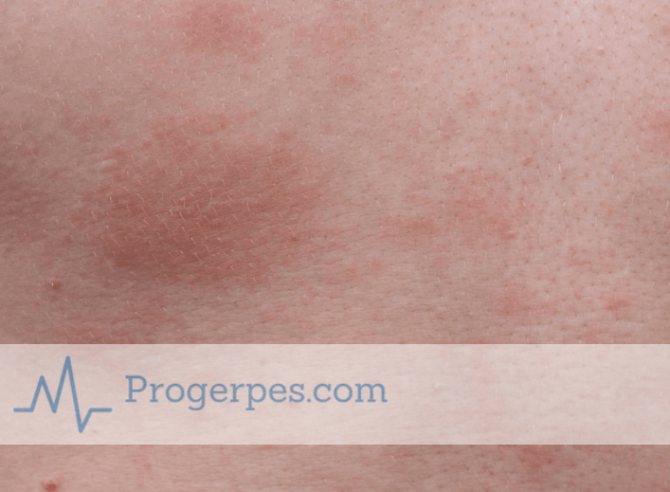
Such papules can leave brown spots behind. Their color depends on the blood supply to this area and the depth of their placement under the skin.
Is treatment necessary?
The disease has no specific treatment. In general, it does not last long, about a week. At this time, it is necessary to help the child, reduce his suffering, create conditions for an easier course of the disease and provide care for the baby.
When parents contact a medical facility, the doctor can conduct additional tests to ensure the accuracy of the diagnosis and advise parents about the care and medications that are used during the period of roseola. Depending on how many days the temperature and rash with roseola lasts, one can judge the severity of the process.
Doctor's help for roseola
No special treatment is required. The disease is usually mild, and recovery in most cases occurs on its own. Antipyretic medications are used to alleviate the baby’s condition.
Antiviral drugs are rarely prescribed: for severe disease or weakened immunity.
Antibiotics are used for complications to fight bacterial infection.
If the child has seizures, the child is hospitalized and anticonvulsants are prescribed. After stopping the attack and in the future, the baby must be observed by a neurologist.
What not to do: use antibiotics, antiallergic and antiviral drugs, lubricate the rashes with antiseptics.
Do not try to treat your child on your own, and in case of any illness, always consult a doctor in a timely manner. It is important that the doctor brings together the manifestations of the disease and test results - be it roseola or a common cold. Correct diagnosis and timely treatment depend on this. Only the experience and knowledge of a competent doctor will help to understand each specific case of the disease.
Doctors' mistakes
The symptoms of sudden exanthema are very vague, dim, and have few specific manifestations. When visiting a doctor, he must conduct the necessary research:
- Examination of the body, external characteristics of the rash, its peculiarity with roseola is paleness after pressing;
- A general blood test, which will indicate a decrease in the number of leukocytes, eosinophils and an increase in lymphocytes;
- Serological reactions - ELISA, which will indicate an increase in antibodies in the blood to the pathogen;
- Polymerase chain reaction (PCR) - provides data about the DNA of the virus to accurately determine its type.
You need to understand that doctors can make mistakes or treat the manifestations of the disease negligently. They may suspect some other cause of the rash, such as an allergy. This is the most common mistake; this is the diagnosis most often made. In such cases, the doctor will prescribe antihistamines, which are not needed to treat pseudorubella. Since, after a few days, roseola goes away on its own, parents do not know about the disease, believing that the prescribed therapy helped in treating the disease.
A serious mistake would be the wrong treatment of rubella. Often, local doctors neglect to conduct tests to calculate the amount of antibodies in the blood. Parents should insist on this themselves before giving their child a prescribed antibiotic. After all, this is a strong medicine that does not make sense in the treatment of a viral disease, can lead to some health complications and cause some microorganisms to become resistant to treatment in the future.
It is not difficult to distinguish these diseases - with rubella, the rash appears at the beginning of the disease, along with a rise in temperature, with roseola - after it, on days 2-4. Depending on age, roseola manifests itself differently. In more mature people, it may go unnoticed at all, or with a slight rise in temperature.
Rash after fever and nothing else - this is roseola infantile - Diagnostician
The child is 11 months old. Temperature 38.3°C for the third day. Nurofen does not help for long. Diarrhea all three days. I've never had an allergy, but yesterday I had it all over my back. The doctor said you have an acute respiratory infection due to teething. When other teeth came in, the temperature did not rise. It doesn’t look like an acute respiratory infection - no runny nose or cough. Lena
I studied this “bastard” on two children :) Only Lena didn’t write it down - when the rash appeared, the fever subsided. This is roseola. Maria
Description of infantile roseola (sudden exanthema): Temperatures above 39°C last for 3-4 days, temperatures below 39°C can last up to 8 days. Fever may be combined with diarrhea, decreased appetite, and headache. There are no other manifestations of the disease - no runny nose or cough. After 3-4 days of persistent fever, a rash appears - first on the face, chest and abdomen, and after a few hours throughout the body. Sometimes the cervical lymph nodes are enlarged, swelling around the eyes and red papules on the soft palate (Nagayama spots). After the rash appears, the temperature no longer rises. The rash goes away in 3-4 days without treatment.
Important. The rash that appears after the temperature normalizes is frightening: “First the temperature, and now the rash!” In fact, this is a sign of the end of the disease.
| Photo Infantile roseola (sudden exanthema): bright spotted and maculopapular rash; herpetic sore throat with ECHO exanthema. |
READ ALSO: How to get rid of wen on the face at home: the best recipes
ECHO-exanthema (infectious exanthema) proceeds in a similar way - a rash appears after the temperature normalizes. With ECHO exanthema, herpetic sore throat and diarrhea are common.
The child is 10 months old. At night the temperature rose to 39.8°C. For three days the temperature did not drop below 38. No runny nose, no cough. On the third day, red spots appeared on the face, head, back and stomach (nothing new was given from food). No temperature. The child doesn't seem to be itching. Kat
If you notice that your temperature has dropped and a rash has appeared, then this may be infantile roseola, and not an allergy to medications. The rash reaches the belly and buttocks, and is often absent on the legs. But this is not a strict rule; it may be on legs. Vita
I'm 32 years old and the exact same thing happened to me. I feel OK. I have no idea where I picked it up. The day before, I drank a little at the bar and ate some rolls and solyanka. Roseola or not roseola, a rash broke out on the third day. I took an allergy pill and there was practically nothing left of the rash. It worked out. Vadim
A very interesting infection with characteristic symptoms. At the beginning the temperature rises and that's it. There is nothing else - no cough, no runny nose. The uncertain state lasts about three days. Then the temperature drops, and the active child runs around the house asking for food. Everyone at home experiences a feeling of deep satisfaction in connection with recovery from an incomprehensible illness. But 10-20 hours after the temperature normalizes, when the child seems absolutely healthy, a small-spotted pink rash suddenly appears all over the body. In three days of an unexplained rise in temperature, parents will have time to “stick” 3-4 medications into their child. Doctors consider the appearance of a mom-dad-baby rash as a sign of a drug allergy. Allergy medications are prescribed. Although the rash usually goes away on its own within 3-7 days. Roseola is a unique disease! It is not dangerous, does not cause complications, and does not require treatment.
Everything matches. We got sick at 6 months - temperature up to 39.5°C, rash after 3 days. The rash went away after 4 days and everything is fine. This is the first acquaintance with the herpes virus. Don't be alarmed. Higher medical education helped not to end up with an infectious disease with roseola :)) Lala
The temperature stood for a long time and was high (without being knocked down by anything), and then dropped sharply. A rash broke out all over my body. I thought it was rubella. The doctor said it was roseola. The result: three days under house arrest and drink more fluids. No antibiotics or other bullshit. Alya
We had the same thing a year ago... After recovery, we tested for viruses. Herpes simplex virus type 6 was found. There were all sorts of infectious disease specialists, and all sorts of regimens they tried. Herpes has no cure. It all comes down to hardening the body. We tried to go to kindergarten 6 times in 2 years - and all attempts ended in the hospital. The immune system is weakened by this infection. And one more thing: after we got over this three-day fever, our temperature is now always 37.1 - 37.6 for the past 2 years. Faith
Sudden exanthema according to ICD10 B08.2. This disease is common in children. Infantile roseola (sudden exanthema) is caused by herpes virus type 6 (HHV-6). Febrile seizures in children under 2 years of age, fever without a focus of infection, and Epstein-Bar negative mononucleosis are often caused by herpes virus infection type 6 (HHV-6). In rare cases, the virus causes fulminant hepatitis and encephalitis, as well as Rosai-Dorfman syndrome (generalized lymphadenopathy).
READ ALSO: Hepatitis rash is the result of impaired liver function
Unfortunately, awareness of this disease among pediatricians and infectious disease specialists is extremely low.
Take care of yourself, Your Diagnosticer !
News MirTesen
